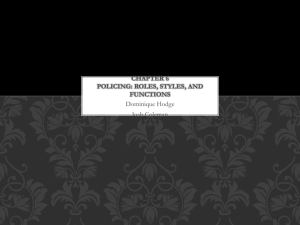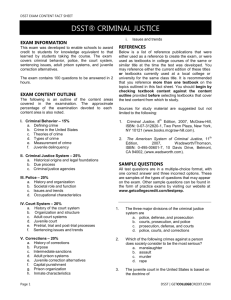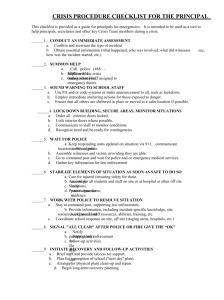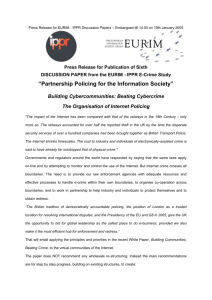DSST® INTRODUCTION TO LAW ENFORCEMENT
advertisement
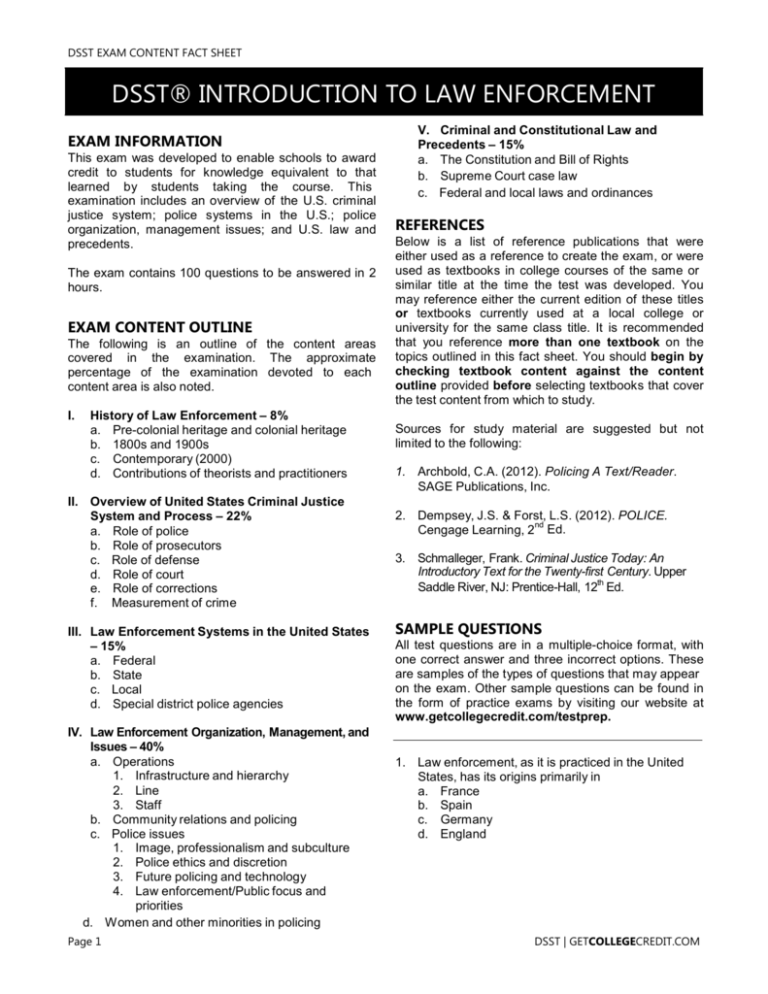
DSST EXAM CONTENT FACT SHEET DSST® INTRODUCTION TO LAW ENFORCEMENT EXAM INFORMATION This exam was developed to enable schools to award credit to students for knowledge equivalent to that learned by students taking the course. This examination includes an overview of the U.S. criminal justice system; police systems in the U.S.; police organization, management issues; and U.S. law and precedents. The exam contains 100 questions to be answered in 2 hours. EXAM CONTENT OUTLINE The following is an outline of the content areas covered in the examination. The approximate percentage of the examination devoted to each content area is also noted. I. History of Law Enforcement – 8% a. Pre-colonial heritage and colonial heritage b. 1800s and 1900s c. Contemporary (2000) d. Contributions of theorists and practitioners II. Overview of United States Criminal Justice System and Process – 22% a. Role of police b. Role of prosecutors c. Role of defense d. Role of court e. Role of corrections f. Measurement of crime III. Law Enforcement Systems in the United States – 15% a. Federal b. State c. Local d. Special district police agencies IV. Law Enforcement Organization, Management, and Issues – 40% a. Operations 1. Infrastructure and hierarchy 2. Line 3. Staff b. Community relations and policing c. Police issues 1. Image, professionalism and subculture 2. Police ethics and discretion 3. Future policing and technology 4. Law enforcement/Public focus and priorities d. Women and other minorities in policing Page 1 V. Criminal and Constitutional Law and Precedents – 15% a. The Constitution and Bill of Rights b. Supreme Court case law c. Federal and local laws and ordinances REFERENCES Below is a list of reference publications that were either used as a reference to create the exam, or were used as textbooks in college courses of the same or similar title at the time the test was developed. You may reference either the current edition of these titles or textbooks currently used at a local college or university for the same class title. It is recommended that you reference more than one textbook on the topics outlined in this fact sheet. You should begin by checking textbook content against the content outline provided before selecting textbooks that cover the test content from which to study. Sources for study material are suggested but not limited to the following: 1. Archbold, C.A. (2012). Policing A Text/Reader. SAGE Publications, Inc. 2. Dempsey, J.S. & Forst, L.S. (2012). POLICE. nd Cengage Learning, 2 Ed. 3. Schmalleger, Frank. Criminal Justice Today: An Introductory Text for the Twenty-first Century. Upper th Saddle River, NJ: Prentice-Hall, 12 Ed. SAMPLE QUESTIONS All test questions are in a multiple-choice format, with one correct answer and three incorrect options. These are samples of the types of questions that may appear on the exam. Other sample questions can be found in the form of practice exams by visiting our website at www.getcollegecredit.com/testprep. 1. Law enforcement, as it is practiced in the United States, has its origins primarily in a. France b. Spain c. Germany d. England DSST | GETCOLLEGECREDIT.COM DSST EXAM CONTENT FACT SHEET – INTRODUCTION TO LAW ENFORCEMENT 2. The majority of law enforcement agencies in the United States are concentrated at what level of government? a. Federal b. State c. County d. Local 3. The rights of free speech and assembly can be found in which of the following amendments? a. First b. Fourth c. Fifth d. Sixth 4. Statistics for the Uniform Crime Reports (UCR) are collected, tabulated, and distributed nationally by a. The Bureau of Standards b. The International Association of Chiefs of Police c. Interpol d. The FBI 5. Which of the following is the "victimless" crime for which persons are most often arrested? a. Embezzlement b. Intoxication c. Adultery d. Sale of pornographic materials CREDIT RECOMMENDATIONS The American Council on Education’s College Credit Recommendation Service (ACE CREDIT) has evaluated the DSST test development process and content of this exam. It has made the following recommendations: Area or Course Equivalent Introduction to Law Enforcement Level Upper-level baccalaureate Amount of Credit Minimum Score Three (3) semester hours Source American Council on Education – College Credit Recommendation Service 400 Answers to sample questions: 1-D; 2-D; 3-A; 4-D; 5-B; 6B; 7-D. 6. Which of the following is best defined as the implementation of scientific principles in the evaluation of evidential items that are in one way or another involved in criminal and other police investigations? a. Criminology b. Criminalistics c. Penology d. Modus operandi 7. One of the first duties of a patrol officer arriving at a major crime scene is to a. Take statements from witnesses b. Notify the victim's next of kin c. Draw a detailed diagram of the crime scene d. Preserve the crime scene Rev 10/2014 Page 2 DSST | GETCOLLEGECREDIT.COM


